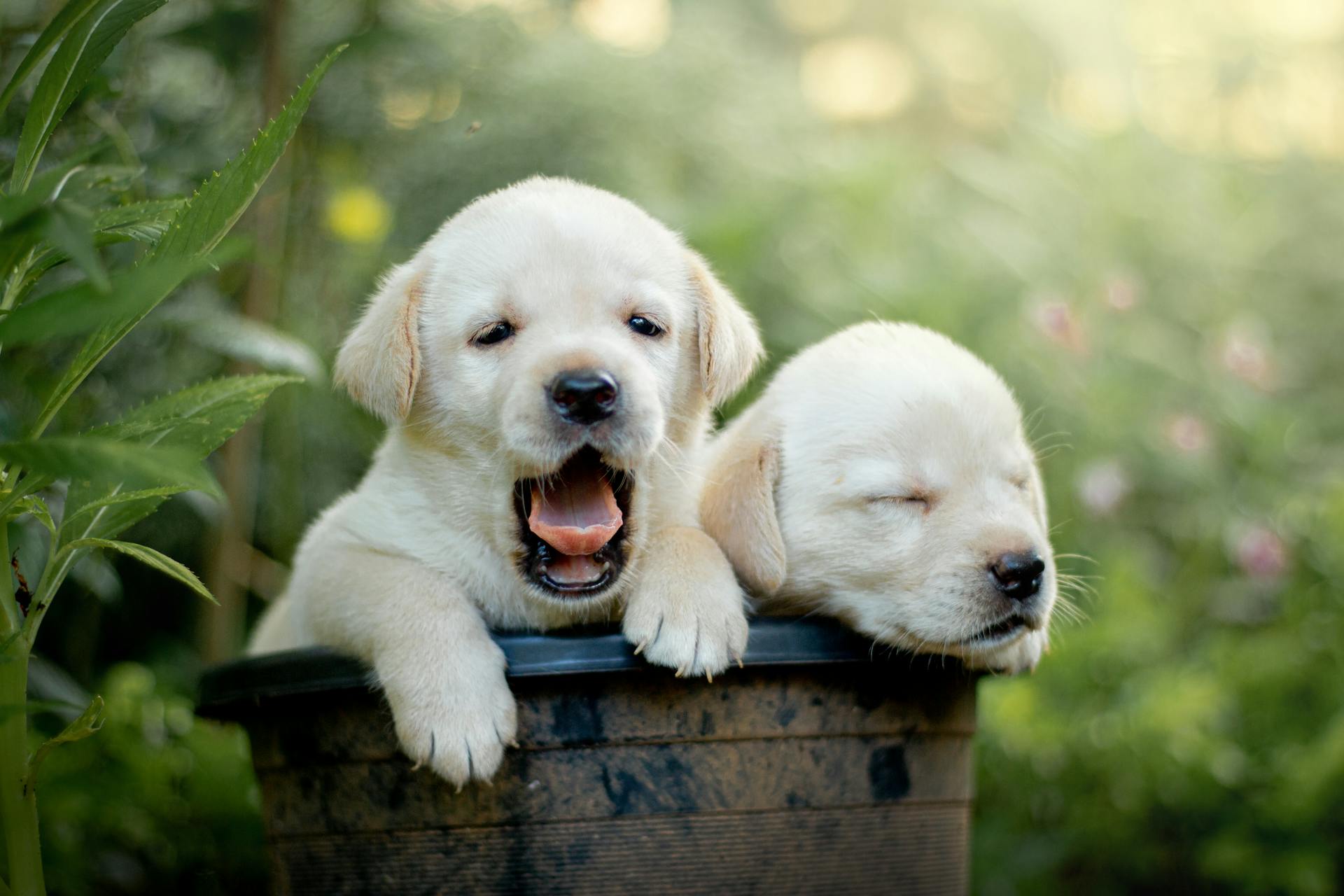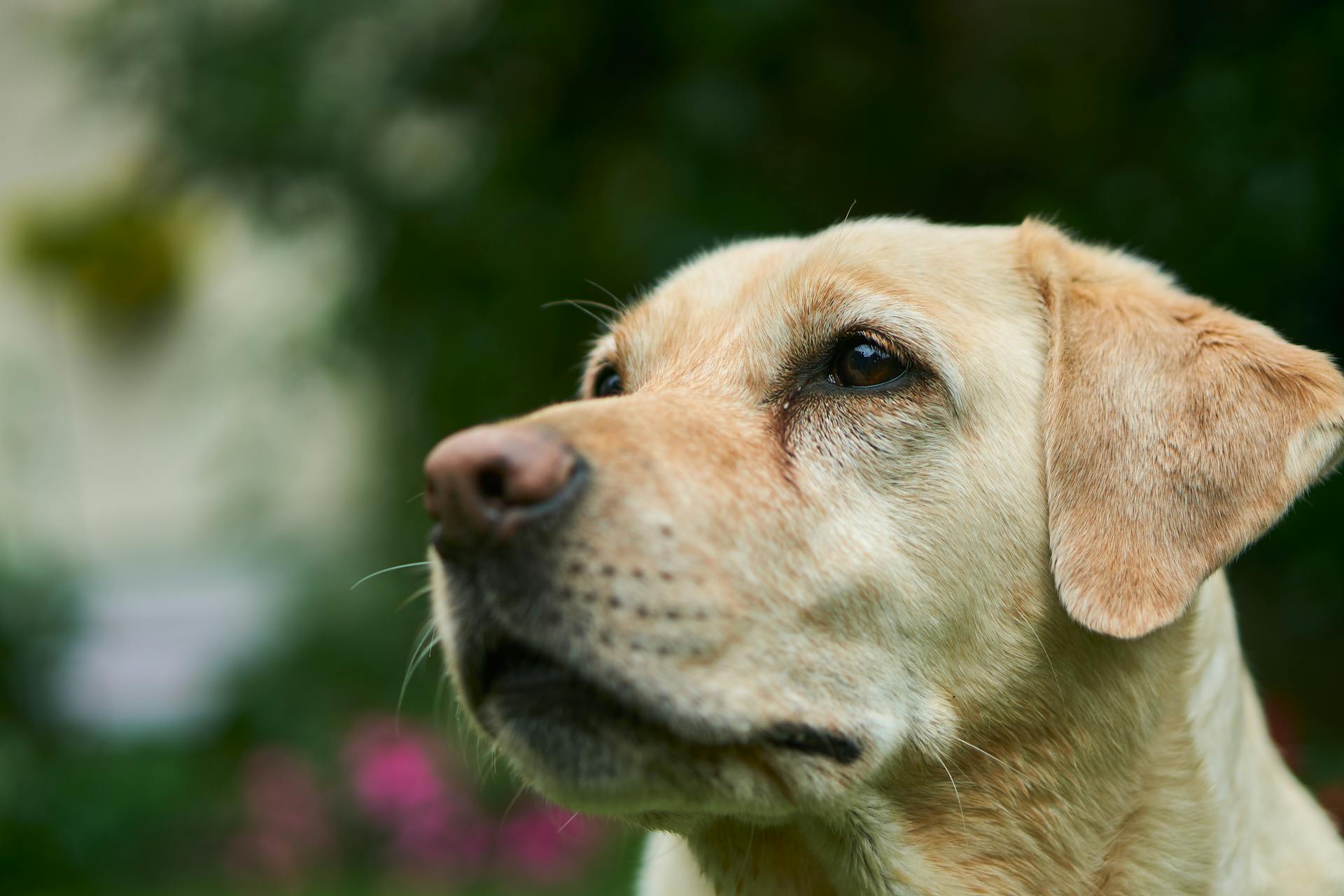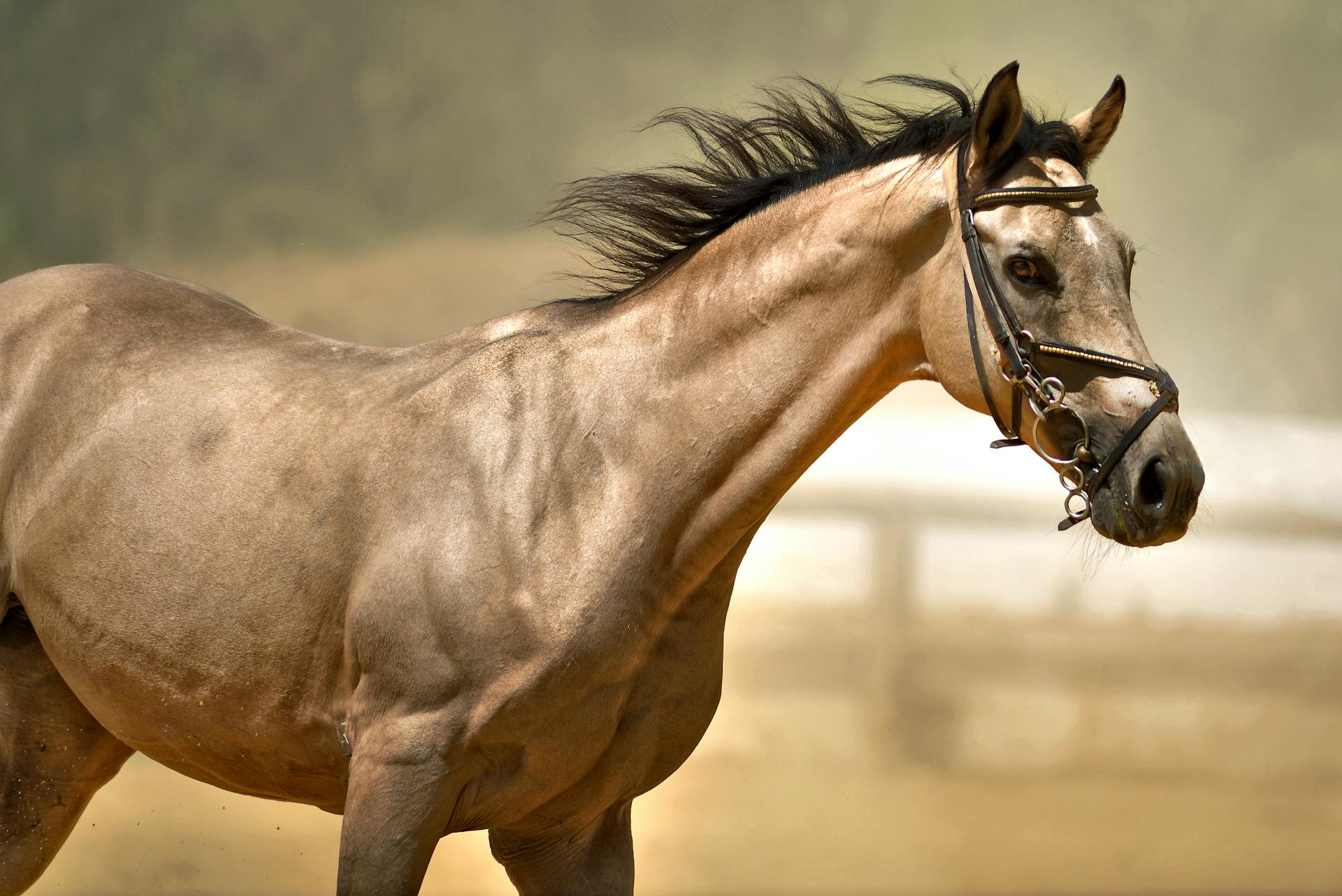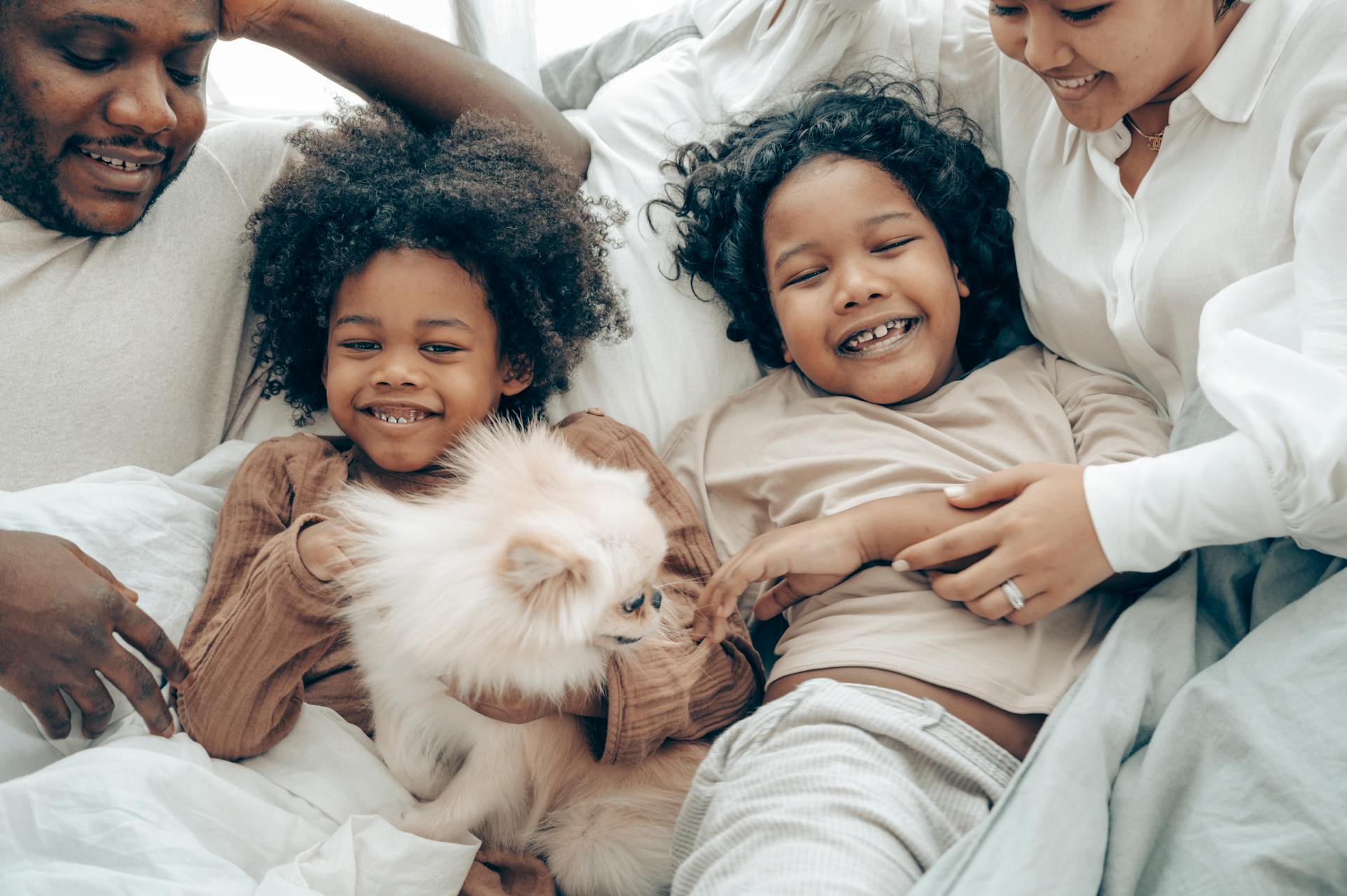
Labradors are a popular breed for many reasons, and one of the most significant is their intelligence. They are one of the smartest dog breeds, ranking 7th in Stanley Coren's book "The Intelligence of Dogs".
Labradors are also known for their loyalty and affection towards their families. They have a strong instinct to please their owners, which makes them highly trainable.
Their high energy level requires regular exercise, but they also enjoy quiet time and can adapt to living in smaller spaces.
Breed Characteristics
Labradors are known for their friendly and outgoing personalities, making them great with people of all ages and other animals.
They're also highly intelligent and easy to train, which is why they're often used as working dogs, such as guide dogs, search-and-rescue dogs, and therapy dogs.
Labradors are active dogs that need plenty of exercise, so if you're not an active person, they may not be the best choice for you.
Here are some key characteristics of Labradors:
- Friendliness: 9/10
- Intelligence: 9/10
- Trainability: 9/10
- Energy level: High
- Grooming needs: Low
Labradors are loyal and devoted dogs that make great family pets, but they do require a lot of time and attention.
Curious to learn more? Check out: Dogs Breeds That Start with B
Information and Pictures
Labrador Retrievers are known for their friendly and outgoing personalities, making them a great choice for families with children. They're good with people of all ages and other animals.
These dogs are intelligent and easy to train, which is why they're often used as working dogs, such as guide dogs, search-and-rescue dogs, and therapy dogs.
Labrador Retrievers are active dogs that need plenty of exercise, enjoying activities like playing fetch, swimming, and other fun stuff. They're not a good choice for people who are not active or who don't have a lot of time to spend with their pets.
Here are some key characteristics of Labrador Retrievers:
- Friendly temperament: good with people and other animals
- Intelligent and trainable: easy to train and often used as working dogs
- Active and playful: need plenty of exercise and enjoy activities like playing fetch and swimming
- Loyal and devoted: make great family pets and are known for their gentle nature
- Grooming needs are minimal: short, thick coats that only need to be brushed a few times a week
In terms of their energy level, Labrador Retrievers can vary, but most are rowdy and need activity to keep them happy. This can be physical activity, like playing fetch, or mental activity, like training exercises.
Size
Labradors are a relatively large breed, with males standing between 22.5 and 24.5 inches tall.
The average height of a Lab is between 21.5 and 24.5 inches, and the average weight is roughly 55 to 80 pounds.
Males typically weigh between 65 to 80 pounds, while females weigh between 55 to 70 pounds.
Labradors' weight and height can vary slightly, but overall, they're a sturdy and athletic breed.
Curious to learn more? Check out: Boerboel Size and Weight
Care and Feeding
Labradors are social animals and need to be around their family to be happy. They're not backyard dogs and will get destructive if left alone for too long.
Daily 30-minute walks, a romp at the dog park, or a game of fetch are great ways to help your Lab burn off energy. They're natural athletes and will exhaust themselves if you let them.
You should take special care when raising a Lab puppy, as they grow rapidly between four and seven months and are susceptible to bone disorders. Feed them a high-quality, low-calorie diet to prevent this.
Here's an interesting read: Chocolate American Lab
Care

Labrador Retrievers are social dogs that thrive on family interaction, so they're not suited for being left alone in a backyard for extended periods. A lonely, bored Lab will likely dig, chew, or engage in other destructive behaviors.
Daily 30-minute walks, playtime at the dog park, or a game of fetch are great ways to help your Lab burn off energy. To avoid exhausting your puppy, keep play sessions short and sweet, with breaks in between.
Labs are natural "workaholics" and will exhaust themselves if not given regular breaks. It's essential to end play and training sessions before your Lab becomes too tired.
Labrador Retrievers are highly trainable, but they require consistent training from an early age. Puppy kindergarten is an excellent place to start, teaching your pup good canine manners and social skills.
To protect your Lab's joints, avoid letting them run and play on hard surfaces like pavement until they're at least two years old. Normal play on grass or puppy agility is fine, with its one-inch jumps.
Keep sturdy toys available at all times to satisfy your Lab's natural instinct to chew. This will help prevent unwanted chewing on furniture or other household items.
Explore further: Interesting Facts about Labrador Retrievers
Feeding

Feeding your Labrador Retriever is a crucial part of their care. A good quality dog food is essential, and the recommended daily amount is 2.5 to 3 cups of dry food a day, divided into two meals.
Their individual needs depend on size, age, build, metabolism, and activity level, so it's not a one-size-fits-all approach. A highly active dog will need more food than a couch potato dog.
You should feed your Lab twice a day rather than leaving food out all the time, and measure their food to ensure they're getting the right amount. This will help keep them in good shape.
A simple eye test can help you determine if your Lab is overweight – look down at them and see if you can spot a waist. If not, it's time to reassess their diet.
You should also check their ribs by placing your hands on their back, thumbs along the spine, and fingers spread downward. If you can't feel but not see their ribs without pressing hard, they need less food and more exercise.
Check this out: Dog Breeds That Don't Need Grooming
Coat Color and Grooming
The Labrador Retriever's coat is a two-layered masterpiece, consisting of a short, thick topcoat and a soft, weather-resistant undercoat. This unique combination helps them thrive in cold and wet conditions, making them perfect for their role as retrievers.
Labradors come in three main colors: chocolate, black, and yellow. Black was the favorite among early breeders, but yellow and chocolate Labs have gained popularity over the years.
The breed's coat is relatively low maintenance, but it does shed a lot. To keep your Lab looking and feeling their best, invest in a quality vacuum cleaner and brush their coat daily, especially during shedding season.
Labs require a bath every two months or so to stay clean and smelling fresh. However, if they get into a mud puddle or something foul, a more frequent bath is in order.
Brushing your Lab's teeth is essential to prevent tartar buildup and bacteria. Aim to brush their teeth at least two or three times a week, and daily brushing is even better for preventing gum disease and bad breath.
Readers also liked: What Is the Best Brush for a Rabbit?

Trimming your Lab's nails is crucial to keep their feet in good condition and prevent scratching. Check their nails regularly and trim them once or twice a month if they're getting too long.
Regular ear checks are vital to detect any signs of infection. Wipe their ears weekly with a cotton ball and gentle ear cleaner to help prevent infections.
Kids
Labradors are a perfect match for families with kids. They're extremely energetic and bouncy, making them the ultimate playmate for young children.
Labradors are very patient and even-tempered, which is essential when it comes to dealing with rambunctious kids. They're also very tolerant of young children, which is a big plus when it comes to family dynamics.
As with any dog, it's essential to teach children how to approach and touch Labradors gently and respectfully. This will help prevent any accidental biting or ear or tail pulling.
Labradors are naturally friendly and loving, which makes them a great fit for families with kids. They'll happily attend a child's birthday party and even wear a party hat if asked to.
Discover more: Is a Yorkie a Good Family Dog
Here are some key things to keep in mind when introducing a Labrador to your family with kids:
- Teach your child never to approach any dog while they're eating or sleeping.
- Supervise any interactions between dogs and young children to prevent biting or ear or tail pulling.
- Train your Labrador to interact with other pets and small animals, and teach your child how to behave around dogs.
By following these simple guidelines, you can create a harmonious home where both your kids and your Labrador can thrive.
Health and Training
Labradors are a joy to train, but it's essential to start early due to their high energy levels. Early training helps them focus.
A Labrador's intelligence and eagerness to please make them thrive in obedience classes, which are also a great way to socialize them. This exposure to positive people, places, and events is crucial for their well-being and behavior.
By enrolling your Labrador in a puppy obedience class, you'll be setting them up for success and laying the foundation for a well-behaved and well-mannered companion.
Training
Training is key for your energetic Labrador, so start early. Early training helps your Labrador focus and become a well-behaved and well-mannered dog.
A Labrador is very intelligent and eager to please, so take advantage of this by providing consistent training.
Check this out: Welsh Corgi Training

Early training also helps you establish a strong bond with your Labrador.
Enrolling your Labrador in a puppy obedience class is a great way to start training and socialize him at the same time.
Socialization is crucial for your Labrador, so expose him to a variety of positive people, places, and events.
You can progress to teaching your Labrador fun tricks once he's mastered the basics.
Broaden your view: Best Dog Training
Health Issues
Labs are a sturdy breed, but they can be prone to hip dysplasia, which is a condition that affects the joints.
Bloat is a serious issue that can affect large breeds like Labs, and it's essential to be aware of the signs and symptoms to prevent it.
If you get your Lab from a reputable breeder, they will likely have been screened for heart conditions, which can be a major health concern for the breed.
Eye problems are also common in Labs, so regular check-ups with a veterinarian are crucial to catch any issues early.
Muscle weakness is another potential issue that Labs may face, and it's often linked to other health problems.
Readers also liked: Chocolate Labrador Problems
Lucy Clark: Eye Contact Between Species

Labradors are unbeatable for meaningful eye contact between species. This is a unique characteristic that sets them apart from other breeds.
Lucy Clark's experience with her labrador, Rosie, is a testament to this. Rosie's calm and faithful presence brought a sense of security and comfort to her family.
The breed's even temperament makes them great with kids. This is one of the many reasons why labradors are a popular choice for families.
Labradors will also eat all your leftovers and minimize your waste like no other dog. This is a practical benefit that can be a big help in managing household waste.
For Lucy Clark, the solid presence of a labrador was a type of faithful calm that said: "I'm here." This is a powerful statement about the emotional connection that can be formed with a labrador.
Related reading: When Do Labradors Calm down
Frequently Asked Questions
Are Labradors the best dogs in the world?
Labradors have held the top spot for a record 31 years, known for their wonderful temperaments and intuitive nature. Their exceptional characteristics make them a popular choice for many dog owners.
What is special about Labrador?
Labradors are known for their exceptional gentleness, intelligence, and easy-going nature, making them a popular choice as family dogs. Their friendly temperament and adaptability to various living situations also contribute to their special appeal.
Why is the Labrador Retriever the most popular dog?
The Labrador Retriever's popularity stems from its exceptional loyalty and ability to form strong bonds with its family, making it a beloved companion for many households. This unique trait, combined with its friendly and outgoing nature, has earned it a spot as one of the world's most popular dog breeds.
Are Labradors the kindest dogs?
Labradors are known for their friendly and intelligent nature, making them a popular choice as both working dogs and family pets. Their desire for human interaction and love of training also contributes to their kind and affectionate reputation.
Are Labs the most intelligent dogs?
No, Labradors are not the most intelligent dogs, but they are considered one of the most trainable and intelligent breeds, ranking 7th in intelligence. Their high trainability makes them a popular choice for many roles, including guiding the blind and assisting people with disabilities.
Sources
- https://dogtime.com/dog-breeds/labrador-retriever
- https://www.dogbreedinfo.com/labrador.htm
- https://medium.com/@labradorsandabrunette/why-labrador-retrievers-are-the-best-dog-breed-ever-96ef4446657e
- https://neaterpets.com/blogs/news/labradors-best-family-dog
- https://www.theguardian.com/commentisfree/2016/feb/23/open-thread-labradors-are-they-really-the-best-dogs-ever
Featured Images: pexels.com


